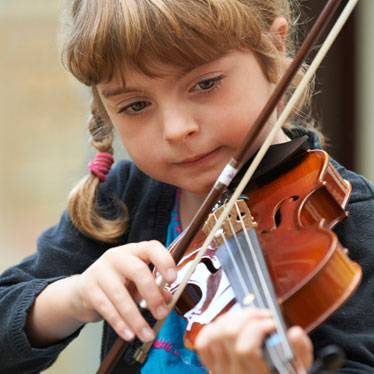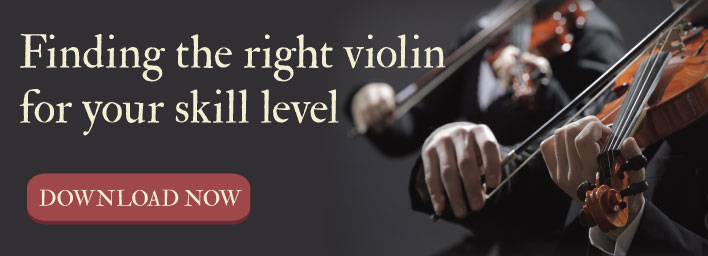How Can I Tell If My Child Has Outgrown His Beginner Violin?

Knowing when to make the change from a beginner violin to an intermediate one can be challenging. Students progress at different levels and various time frames, and there are so many different factors involved in learning to play the violin that oftentimes parents are confused about when to start looking at upgrades for their child’s instrument.
However, if you’re uncertain about how to tell if your child has outgrown his or her beginner violin, these signs can help clear the air, so to speak, and give you the information you need to make the best decision.
Basically, “outgrowing” a beginner violin happens because of one or two reasons: Physical growth or performance progress. Both reasons are legitimate.
Physical Growth
If your child began violin lessons with a properly sized instrument, it’s possible that the violin has become too small for comfortable playing. If that is the case, take your time when choosing a new instrument. One of the worst mistakes you can make when choosing a violin is to purchase an instrument that is too big for your child. A violin that is too big can cause serious physical problems.
Smaller is better, even if your child is between sizes. For example, Joshua Bell (who happens to be rather tall) plays on a full size violin, which may seem a bit on the small size for him. However, that does not hinder his amazing talent or performance ability.
Correct violin sizing takes time, and it involves more than just a few checks. Choosing a violin size by age, height, or the yardstick method alone just won’t cut it. Consider these additional parameters:
- The length and size of your child’s fingers, and width of the palm
- How wide are your child’s shoulders?
- Can your child easily support (hold) the violin using only his or her head?
- Make sure you measure (yardstick method) from the collarbone to the wrist
- Does the instrument appear visually proportionate to your child’s body size, weight, etc. when compared with an adult player?
Too large a violin stifles student progress because it is difficult for your child to command, it hinders flexibility, and it becomes too heavy after only a short time of practice. These things work to create discouragement and frustration for any level musician.
Plus, consistently playing on a violin that is too big can cause injuries by forcing your child to contort his or her body into poor alignment. The pain and possible Carpal tunnel syndrome, headaches, scoliosis, jaw tension, and other problems that can result are easy to aviod by playing on a properly sized instrument.
So, before you commit to a larger instrument, make certain that your child is physically ready for it:
- Place the violin in the playing position for the child
- Can the child wrap his or her fingers around the scroll so that the fingers fall directly in the middle of the peg box? It’s too small if the fingers sit properly but the bend in the arm is very large. It’s too big if your child has to push his or her shoulder out to reach.
- While holding the violin in the playing position, the scroll should reach the wrist when the student extends his or her arm all the way out.
- Look at the child from the back, the violin shouldn’t be wider or significantly thinner than the child’s shoulder.
- Finger reach—With the first finger on the E string, the child should be able to easily place his or her fourth finger D (pinky) on the G string.
Many times students will view moving to a larger instrument as a mark of progress. However, if you’ve purchased a quality manufactured beginner violin, the tonal depth, warmth, and sound produced by a precision instrument will provide years of playing enjoyment. Unless it becomes absolutely too small, it’s better to wait. You may want to try introducing better quality strings, or investing in a bow upgrade first.
Look for these problems to know if the violin is too small:
- Very large bend in the left elbow while playing
- Intonation becomes a bit skewed (but it wasn’t before)
- Odd angle of the bow arm might cause the bow to hug the fingerboard (but it didn’t before)
Performance Progress
Many times children need to move to an intermediate instrument due to performance progress. They’ve essentially ‘outgrown’ their current violin and would benefit from an intermediate level instrument. And, when this is the case, choosing the next level violin is very important.
Most likely, your child will use an intermediate violin for many years, so take your time when making the purchase. Visit a variety of dealers, take along extra sets of ears, and have your child play each instrument as many times as necessary before making the final decision.


